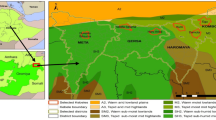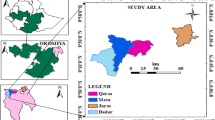Abstract
Legumes are a critical component of many agricultural systems and a major contributor to global food systems. Common bean (Phaseolus vulgaris L.) is the most widely grown legume crop in Ethiopia. It is an important source of food, income, and soil fertility management in southwestern (SW) and northeastern (NE) Ethiopia, and used as medicine, fodder, and honeybee forage in the NE. Diversity and use of farmers’ varieties of common bean (Phaseolus vulgaris) bean were investigated in five administrative zones in SW and NE Ethiopia. Structured and semi-structured interviews were conducted with 288 general informants and 48 key informants in five agroecological zones inhabited by four cultural groups. Thirty-nine varieties were identified based on farmers’ naming practices. Varietal richness and diversity were found to be highest in the humid, tepid mid-highlands of Kefa (13) and Bench Maji and Sheka (12). However, farmers in both research areas typically plant only one or two varieties. Interestingly, the number of varieties per household was highest (2.3) in South Wollo Zone of the NE, where only six varieties were found. We find that varieties per household are limited by small landholdings in the SW and varietal richness in the NE. Given these limitations, policies and programs to conserve varietal diversity and increase productivity are more likely to be effective if organized at the community level in the SW and the household level in the NE. Agromorphological and genetic characterization of common bean varieties would facilitate the management and conservation of their diversity as a source of resilience.










Similar content being viewed by others
References
Ajao AM, Oladimeji YU, Babatunde SK, Obembe A (2014) A study of the use of honey and ethno-biological components in Nigerian trado-medical practices. Br J Appl Sci Technol 4(19):2796
Altieri MA (1999) The ecological role of biodiversity in agroecosystems. Agric Ecosyst Environ 74:19–31
Asfaw A, Blair MW, Almekinders C (2009) Genetic diversity and population structure of common bean (Phaseolus vulgaris L.) landraces from the East African highlands. Theor Appl Genet 120:1–12
Asfaw A, Almekinders CJ, Struik PC, Blair MW (2013) Farmers’ common bean variety and seed management in the face of drought and climate instability in southern Ethiopia. Sci Res Essays 8(22):1022–1037
Bareke T, Asfaw Z, Woldu Z, Medvecky B, Amssalu B (2018) Diversity of common bean (Phaseolus vulgaris L., Fabaceae) landraces in parts of southern and eastern Ethiopia. Adv Plants Agric Res 8(6):449–457
Bellon MR (2004) Conceptualizing interventions to support on-farm genetic resource conservation. World Dev 32(1):159–172
Brown GG, Swift MJ, Bennack DE, Bunning S, Montáñez A, Brussaard L (2007) Management of soil biodiversity in agricultural systems. In: Jarvis DI, Padoch C, Cooper HD (eds) Managing biodiversity in agricultural ecosystems. Columbia University Press, New York, pp 224–268
Brush SB (1995) In situ conservation of landraces in centers of crop diversity. Crop Sci 35:346–354
Conway D, Schipper ELF (2011) Adaptation to climate change in Africa: challenges and opportunities identified from Ethiopia. Glob Environ Change 21(1):227–237
CSA (2015) Agricultural Sample Survey, report on area and production of major crops. Private peasant holdings, Meher Season, Addis Ababa, Ethiopia
Dagnew K, Haileselassie T, Feyissa T (2014) Genetic diversity study of common bean (Phaseolus vulgaris L.) germplasm from Ethiopia using inter simple sequence repeat (ISSR) markers. Afr J Biotechnol 13(36):3638–3649
Gaudin ACM, Tolhurst TN, Ker AP, Janovicek K, Tortora C, Martin RC, Deen W (2015) Increasing crop diversity mitigates weather variations and improves yield stability. PLoS ONE 10(2):e0113261
Heuze V, Tran G, Lebas F, Noziere P (2013) Common bean (Phaseolus vulgaris), Feedipedia.org—animal feed resources information system A programme by INRA, CIRAD, AFZ and FAO. http://www.feedipedia.org/node/266. Accessed 17 July 2019
Hodgkin T, Rana R, Tuxill J, Balma D, Subedi A, Mar I, Karamura D, Valdivia R, Collado L, Latournerie L, Sadiki M, Sawadogo M, Brown AHD, Jarvis DI (2007) Seed systems and crop genetic diversity in agroecosystems. In: Jarvis DI, Padoch C, Cooper HD (eds) Managing biodiversity in agricultural ecosystems. Columbia University Press, New York, pp 77–116
Jarvis DI, Padoch C, Cooper HD (2007) Biodiversity, agriculture, and ecosystem services. Managing Biodiversity in agricultural ecosystems. In: Jarvis DI, Padoch C, Cooper HD (eds) Managing biodiversity in agricultural ecosystems. Columbia University Press, New York, pp 1–12
Kiwuka C, Mulumba, JW, Adokorach J, Nankya, R (2011) Relating crop damage levels on-farm to crop varietal diversity measured by richness, evenness and diversity for common bean in Uganda. In: Jarvis DI, Fadda C, De Santis P, Thompson T (eds) Damage, diversity and genetic vulnerability: the role of crop genetic diversity in the agricultural production system to reduce pest and disease damage. Proceedings of an international symposium 15–17 February 2011, Rabat, Morocco, pp 45–54
Legesse H, Dechassa N, Gebeyehu S, Bultosa G, Mekbib F (2013) Response to soil acidity of common bean genotypes (Phaseolus vulgaris L.) under field conditions at Nedjo, Western Ethiopia. Sci Technol Arts Res J 2(3):3–15
Loko L, Orobiyi A, Adjatin A, Akpo J, Toffa J, Djedatin G, Dansi A (2018a) Morphological characterization of common bean (Phaseolus vulgaris L.) landraces of Central region of Benin Republic. J Plant Breed Crop Sci 10(11):304–318. https://doi.org/10.5897/jpbcs2018.0766
Loko L, Toffa J, Adjatin A, Akpo AJ, Orobiyi A, Dansi A (2018b) Folk taxonomy and traditional uses of common bean (Phaseolus vulgaris L.) landraces by the sociolinguistic groups in the central region of the Republic of Benin. J Ethnobiol Ethnomed 14:52. https://doi.org/10.1186/s13002-018-0251-6
Maryo M, Nemomissa S, Bekele T (2015) An ethnobotanical study of medicinal plants of the Kembatta ethnic group in Enset-based agricultural landscape of Kembatta Tembaro (KT) Zone, Southern Ethiopia. Asian J Plant Sci Res 5(7):42–61
Mekbib F (2007) Infra-specific folk taxonomy in sorghum (Sorghum bicolor (L.) Moench) in Ethiopia: folk nomenclature, classification, and criteria. J Ethnobiol Ethnomed 3:38
Miles CA (2002) Niche market dry bean variety trial. USDA. Annu Rep Bean Improv Coop 45:224–225
MoARD (Ministry of Agriculture and Rural Development) (2005) Major agro-ecological zones of Ethiopia. Forestry, Land Use and Soil Conservation Department, Addis Ababa
Olango TM, Tesfaye B, Catellani M, Pè ME (2014) Indigenous knowledge, use and on-farm management of enset (Ensete ventricosum (Welw.) Cheesman) diversity in Wolaita, Southern Ethiopia. J Ethnobiol Ethnomed 10(1):41
Padulosi S, Heywood V, Hunter D, Jarvis A (2011) Underutilized species and climate change: current status and outlook. In: Yadav S, Redden R, Hatfield J, Lotze-Campen H, Hall A (eds) Crop evolution to climate change. Wiley-Blackwell, Chichester, pp 507–521
Petry N, Boy E, Wirth JP, Hurrell RF (2015) The potential of the common bean (Phaseolus vulgaris) as a vehicle for iron biofortification. Nutrients 7:1144–1173
Picasso VD, Brummer EC, Liebman M, Dixon PM, Wilsey BJ (2011) Diverse perennial crop mixtures sustain higher productivity over time based on ecological complementarity. Renew Agric Food Syst 26(4):317–326
Rahmato NR (2007) Determinants of adoption of improved haricot bean production package in Alaba special woreda, southern Ethiopia. Dissertation, Haramaya University
Redford KH, Brosius JP (2006) Diversity and homogenization in the endgame. Glob Environ Change 16:317–319
Russell K, Bessin R (2008) Integration of Trichogamma ostriniae releases and habitat modification for suppression of European corn borer (Ostrinia nubilalis Hübner) in bell peppers. Renew Agric Food Syst 24(1):19–24
Santalla M, Casquero PA, De Ron AM (1999) Yield and yield components from intercropping bush bean cultivars with maize. J Agric Crop Sci 183:263–269
Sibhatu KT, Qaim M (2018) Farm production diversity and dietary quality: linkages and measurement issues. Food Secur 10:47–59
Sthapit B, Padulosi S, Mal B (2010) Role of on-farm/in situ conservation and underutilized crops in the wake of climate change. Indian J Plant Genet Resour 23(2):145
Villa TCC, Maxted N, Scholten M, Ford-Lloyd B (2006) Defining and identifying crop landraces. Plant Genet Resour 3(3):373–384. https://doi.org/10.1079/PGR200591
Wortmann, CS, Eledu CA (1997) Distribution of bean seed types in Eastern Africa. Bean Improvement Cooperative. Annual Report. FAO USA, vol 40, pp 30–31
Acknowledgements
The authors would like to acknowledge support from Mekelle University, Haramaya University, Jimma University, Addis Ababa University, Wollo University, and Cornell University. We would like to thank the farmers we interviewed and the zonal, district, and sub-district administrators who facilitated the research. We would like to thank Kochito Gebremariam for Kefi Noono spellings and Demeke Negussie at the Ethiopian Institute for Agricultural Research who helped with the map design. We would also like to thank the McKnight Foundation’s Collaborative Crop Research Program for financial and technical support under CCRP Grant 15-258.
Funding
This study was funded by the Collaborative Crop Research Program of the McKnight Foundation (CCRP Grant 15-258).
Author information
Authors and Affiliations
Corresponding author
Ethics declarations
Conflict of interest
The authors declare that they have no conflict of interest.
Ethical standards
The research protocol (#1605006357) was determined to be exempt from review by the Institutional Review Board for Human Participants at Cornell University (USA) on the basis that the research consists of interviews that pose minimal risk to interviewees. Free and informed oral consent was obtained by the two first authors from all participants prior to each interview.
Additional information
Publisher's Note
Springer Nature remains neutral with regard to jurisdictional claims in published maps and institutional affiliations.
Rights and permissions
About this article
Cite this article
Abera, B., Berhane, M., Nebiyu, A. et al. Diversity, use and production of farmers’ varieties of common bean (Phaseolus vulgaris L., Fabaceae) in southwestern and northeastern Ethiopia. Genet Resour Crop Evol 67, 339–356 (2020). https://doi.org/10.1007/s10722-019-00877-4
Received:
Accepted:
Published:
Issue Date:
DOI: https://doi.org/10.1007/s10722-019-00877-4




